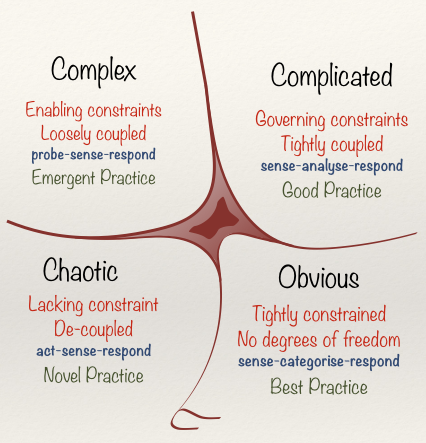# Cynefin framework

The Cynefin Framework is a tool created by Dave Snowden that helps you contextualise problems. Tension between arguments tend to happen when the arguments are given for a different contexts. It is important distinguish a framework and a model: a model represents a reality, a framework makes sense of reality.
One way for you to understand in which context you’re in is to understand the cause-and-effect relationship of a solution:
- Obvious: Clear cause-and-effect of a solution
- Complicated: Cause-and-effect can be understood with the help of expert knowledge in the solution
- Complex: Everyone can’t fully understand the cause-and-effect of a solution
- Chaos: There is no relationship between the cause-and-effect.
Disorder is a context that’s missing in the picture. You’re in disorder context when you don’t know in which context you’re in, or none of the contexts are dominant. You have to gather more information as fast as you could and move out of the disorder context.
I first discovered this when I saw Dave Snowden’s talk in the Craft Conference, unfortunately I can’t find the recording of that talk. You may find this similar talk useful: Complex Adaptive Systems - Dave Snowden - DDD Europe 2018 - YouTube (opens new window). I also find the article published by Liz Keogh to be the one that I visit periodically to grasp a better understanding of Cynefin: Cynefin for Everyone! | Liz Keogh, lunivore (opens new window).
# References
The quiddity of Cynefin - Cognitive Edge (opens new window)
A model seeks to represent reality, a framework is a way of looking, a way of making sense which is very different
# Backlinks
- Complex problem assumed ordered
- There are differrent domains in the Cynefin framework.
- Complex domain
- One of the domain from the Cynefin framework.
- Probe-Sense-Respond
- The decision model from Cynefin framework for Complex domain.
- How and when should the word scan be used in Cynefin?
- One of the theme I noticed from Cynefin framework practitioners is the use of word scan, which is pretty pervasive in Cynefin Basecamp Nov 2023.
- Cynefin domains
- The domains in the Cynefin framework.
- Cynefin drew from multiple disciplines is to align reality and perception
- We often have a conflict of what we perceive and the things that exist, the Cynefin framework attempts to let you see this through multiple disciplines:
- Confused domain
- One of the domain from Cynefin framework.
- Bounded applicability
- Bounded applicability is one of the principle from Cynefin framework in highlighting that most approaches we know are valid when they're applied to the right context or domains.
- Cynefin domains can be derived from emotions
- Having been thinking through the Cynefin framework, I realised I'm in the Confused domain when I'm feeling confused.
- Cynefin practitioners prefer hexagonal sticky notes
- One of the interesting thing I discover from Cynefin Basecamp Nov 2023 is the Cynefin framework seems to prefer the hexagonal sticky notes.
- Exaptive Practice
- A practice for complex domain from Cynefin framework.
- Linear Cynefin
- The flat version of the Cynefin framework.
- §What's top of mind